From the Field
October 22:
Gavin Bieber on his recently concluded tour to South Australia and Northern Territory
The Central Australia tour was excellent this year. Our first leg around Adelaide took in Birdlife Australia's Gluepot Reserve, with its Emus and Galahs (below) as well as a great selection of coastal and wetland birding around the city. Then we traveled to the heart of the outback in the MacDonnell Ranges around Alice Springs, where Port Lincoln Parrots (below), jewel-like Western Bowerbirds (below) and the unlikely looking Spinifex Pigeon (below) were all favorites.
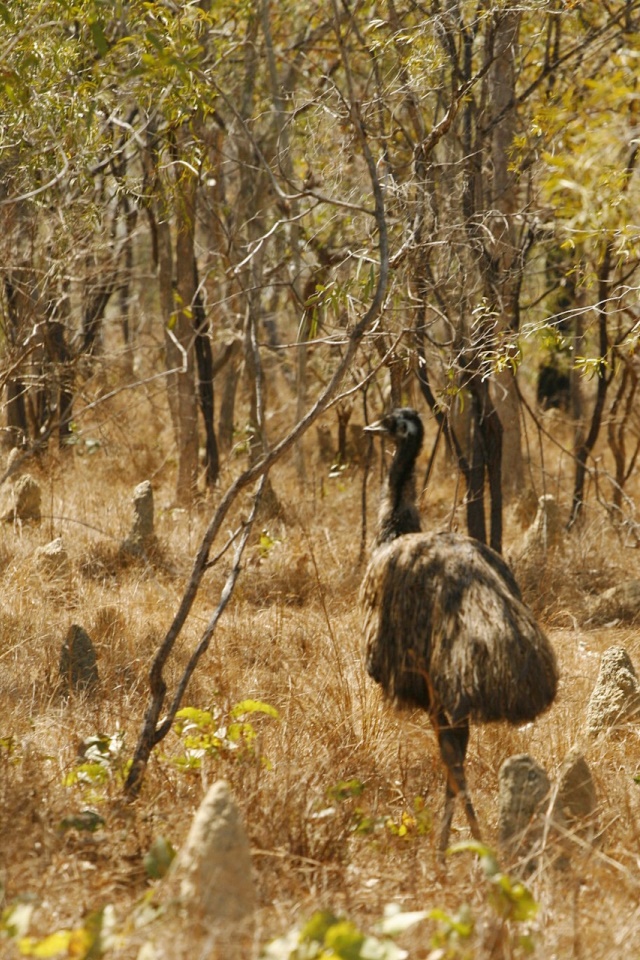
Emu
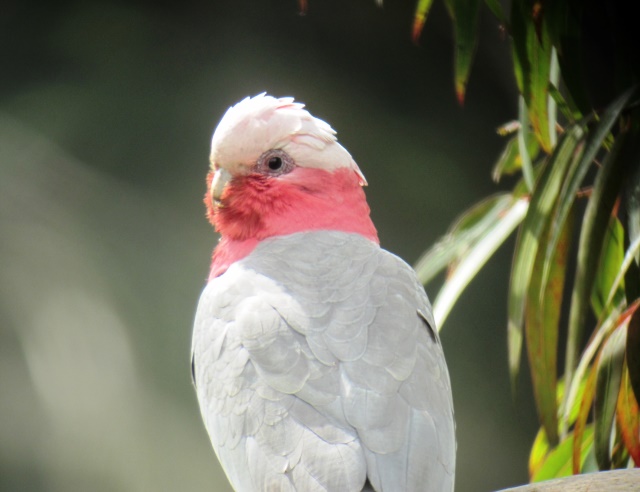
Galah
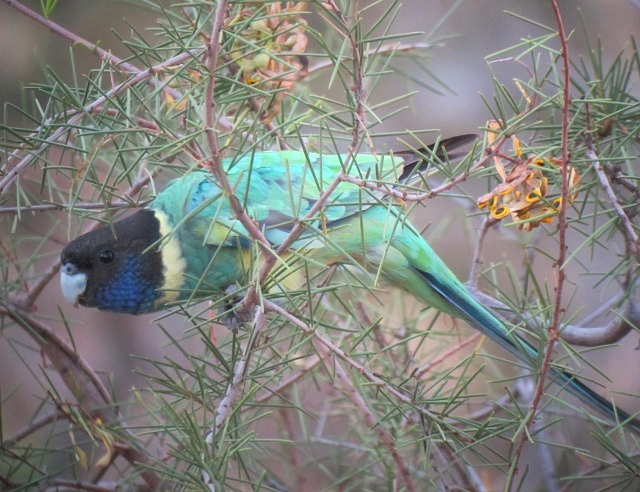
Port Lincoln Parrot

Western Bowerbird
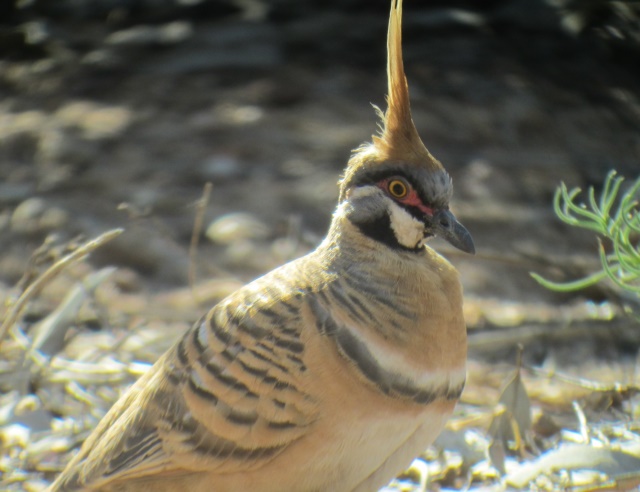
Spinifex Pigeon
We wrapped up with a great five days around the tropical Top End. Based in Darwin, and timed to coincide with the end of the dry season we found throngs of waterbirds stuffed into the remaining ponds and lakes. Huge Black-necked Storks (below) and fields full of Magpie Geese (below) were particularly well enjoyed. One real highlight this year was furnished by two Rufous Owls (below) that were roosting behind a private home a little out of Darwin. And of course, this being the tropics, and Australia, I would be remiss in mentioning the dazzling Red-collared Lorikeets (below) that are common even around downtown Darwin, or the stunning and generally confiding Rainbow Pittas (below) that lurk in the rainforest patches around town. It was great way to end a trip that covers such a wide array of habitats, and tallied just a tad under 300 species of birds!
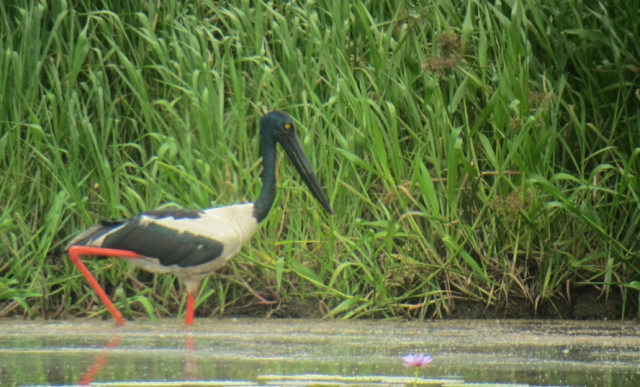
Black-necked Stork

Magpie Geese
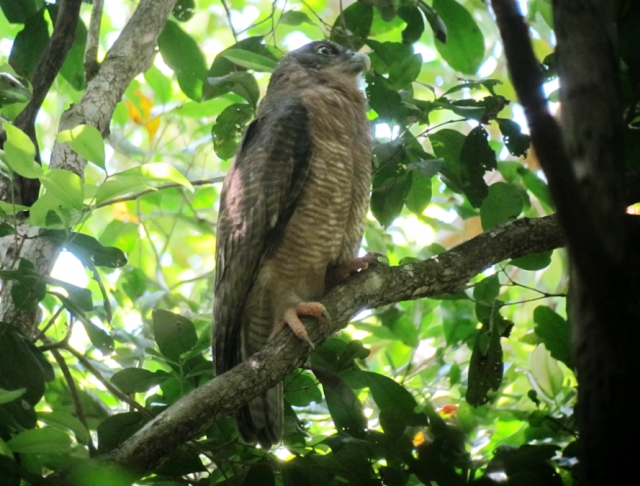
Rufous Owl

Red-collared Lorikeet
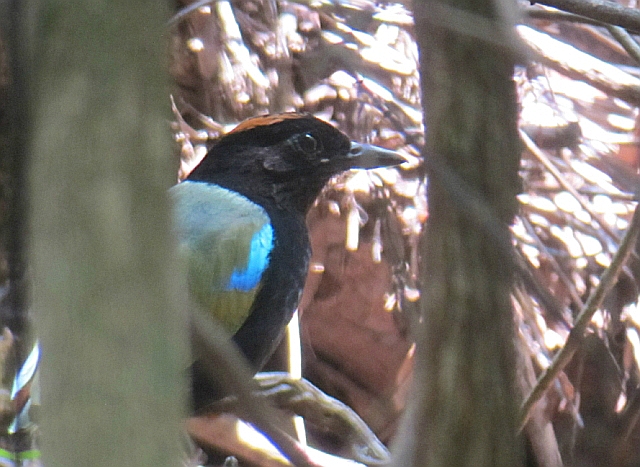
Rainbow Pitta
October 21:
Steve Rooke on his recently concluded tour to South Africa
Our tour got off to a cracking start with a sighting of a Pangolin walking along the roadside. We had only just set off when we found this rare creature, a life mammal for everyone present.
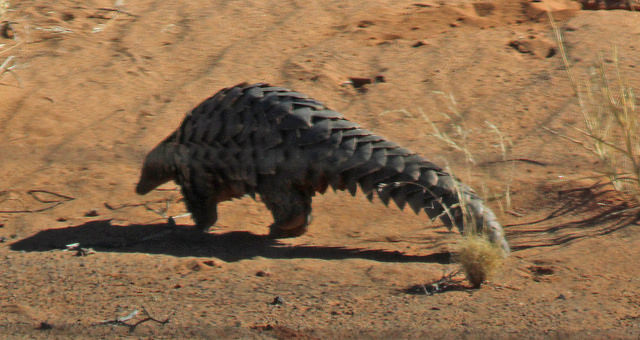
The amazing and prehistoric-looking Pangolin
Elsewhere we watched flights of Namaqua and Burchell’s Sandgrouse coming to drink at a Kalahari waterhole, enjoyed the spectacular wildflowers of Namaqualand,
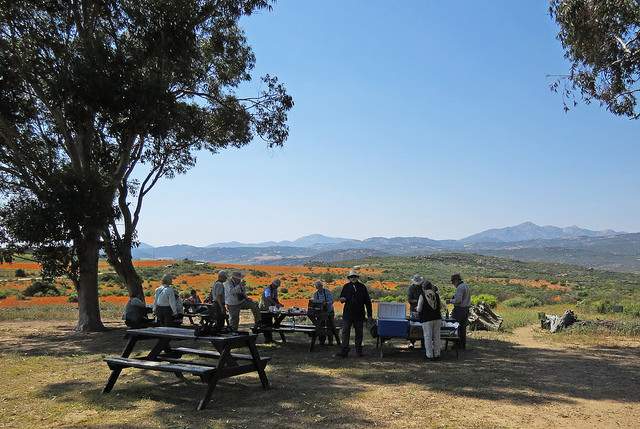
A picnic lunch amidst the flowering Namaqualand
encountered 18 species of lark including the rare Red,
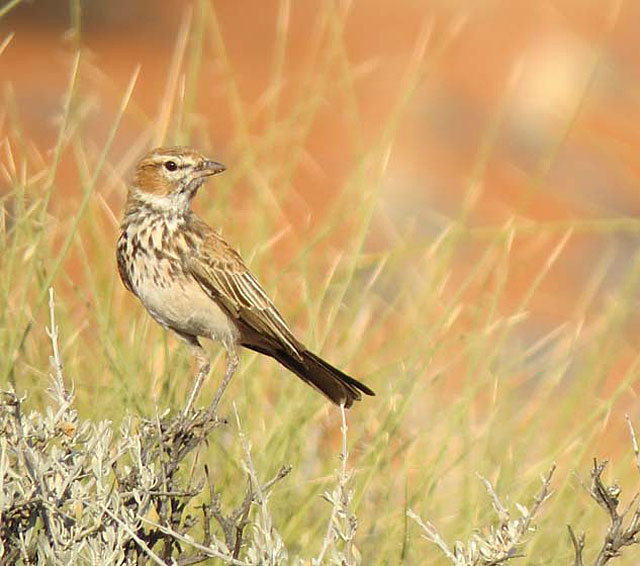
The sought-after Red Lark
went eyeball to eyeball with thousands of Cape Ganets, tracked down Cinnamon-breasted Warbler in the vast Karoo, marvelled at Black Harriers drifting over the fynbos,
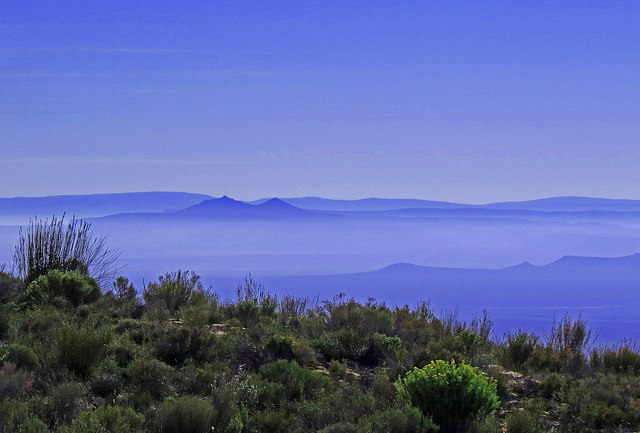
The Great Karoo at dawn
and found ourselves surrounded by hordes of Shy and Black-browed Albatrosses, Pintado and White-chinned Petrels, and swarms of Wilson’s Storm Petrels during our pelagic out of Cape Town.
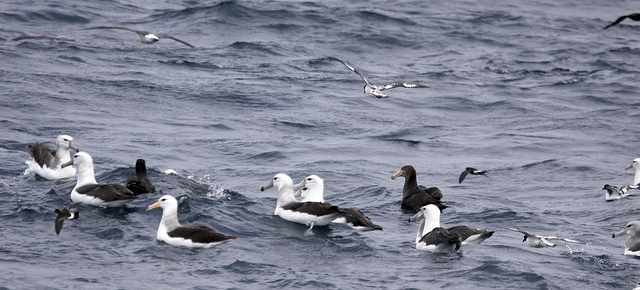
Pelagic birding off Cape Town is usually amazing
And amongst all these wonderful birds we enjoyed some out standing food (including a seafood extravaganza) and superb wine - and we cannot wait to get back there next year.
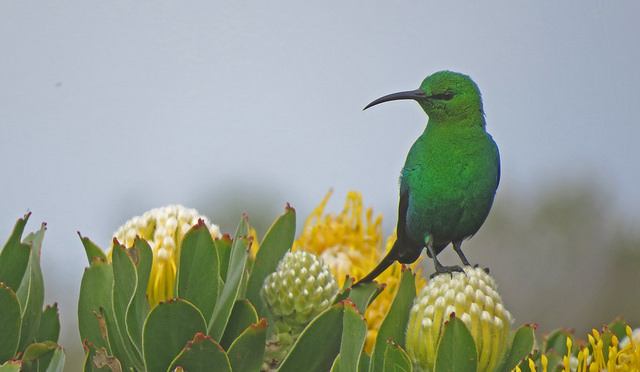
Wild South Africa in an image; a Malachite Sunbird on a Protea
October 16:
Jake Mohlmann on his recent tour, Arizona and Utah: Fall Migration in the Canyonlands
While Hurricane Norbert brought record amounts of rain to California and southern Arizona our 2014 Fall Migration in the Canyonlands tour managed to avoid all the inclement weather, save a few scattered showers here and there.
Beginning and ending in Phoenix allowed us to pick up a suite of the Sonoran Desert species not seen anywhere else on our tour such as Broad-billed Hummingbird, Gambel’s Quail, and the riparian-obligate Abert’s Towhee.
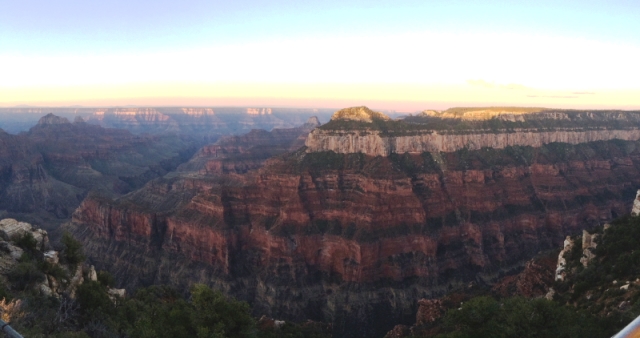
As the sun hits the rim during sunrise at Grand Canyon
The North Rim of the Grand Canyon produced exciting interactions with a female Williamson’s Sapsucker, Brown Creeper, and numerous White-throated Swifts darting by at eye-level. The sunrise overlooking Bright Angel fault and the vast canyon was as unforgettable as ever.
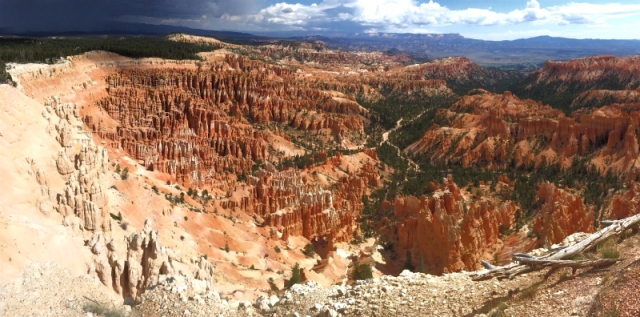
An impending rainstorm approaching Inspiration Point from the west at Bryce Canyon.
Bryce and Zion Canyons exhibited the upper layers of the “Grand Staircase” in glorious hues of orange and red. Our group enjoyed close-encounters with Mountain Chickadees, Green-tailed Towhees, Virginia’s Warblers, and a complete surprise pair of Greater Sage-Grouse while traversing the high plateaus of southwestern Utah.
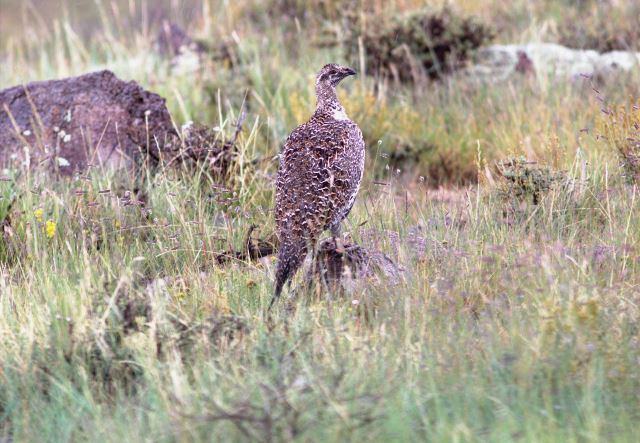
Greater Sage-Grouse, a lifer for everyone on the tour!
The Navajo Reservation provided experiences with a few magical canyons including the fluid sandstone lines in Antelope Canyon, the isolated monoliths of Monument Valley with a moonrise backdrop, and modern Navajo farmers tending to their crops below the sheer cliffs of Canyon de Chelly.
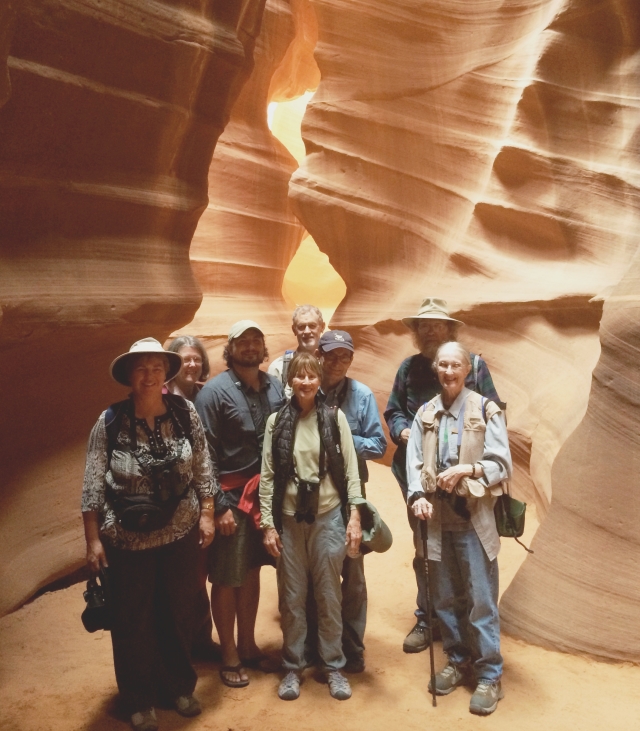
Our group excited to be at Antelope Canyon
Spending two full days in the White Mountains of central Arizona allowed us to relax and enjoy the cool montane air where several avian highlights were experienced. A tooting Northern Pygmy Owl kept our attention while we all watched attentively through the scope. Just down the road a gathering of Clark’s Nutcrackers amused the group with their antics a few meters away while everyone got great pictures of them cracking nuts.
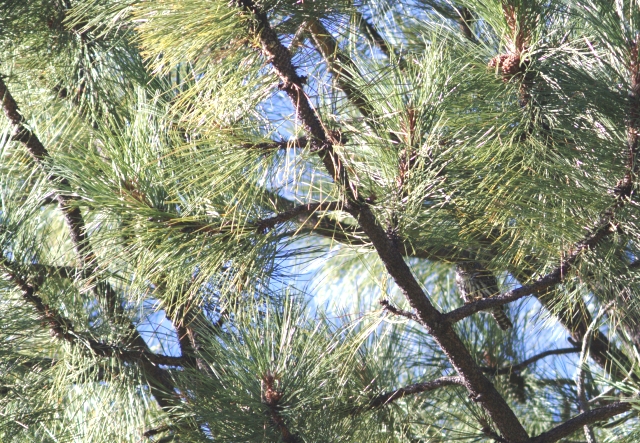
Northern Pygmy Owl
We were able to mop up lots of exciting species our last day as we traveled from the high elevation pine forests back down to the Sonoran Desert regions below. One particular spot of interest produced a mixed flock including at least 6 Grace’s Warblers, 2 male Hepatic Tanagers, a singing Painted Redstart, and obliging family of Mexican Jays.
October 10:
Rich Hoyer on the completion of his and Jim Brock's tour, Peru: Butterflies and Birds.
Our first butterfly and bird watching tour to the Kosñipata Valley of SE Peru, with Jim Brock co-leading as the butterfly expert, was wonderful. Here’s Jim with a Comnena Jewel, Perisama comnena, on the underside of his hat brim, emblematic of how abundant and beautiful the butterflies were this trip.

Jim with Perisama comnena
We started with a short stop at a very high pass on the dry side of the Andes, a couple hours’ drive north of Cusco. It’s often cloudy and cold here, but with a little bit of sun on this windswept ridge, Jim spotted a butterfly he had been hoping to see for years, an obscure but delightful satyr called Argyrophorus lamna, which we dubbed the Silver Puna. The upper side of the forewing shimmers silver in flight.

Argyrophorus lamna, Silver Puna
Over the next days we progressed down the wet, forested slope of the relatively low ridge starting at Acjanaco Pass, where one skirts the upper edge of Manu National Park, ending at Villa Carmen at Pilcopata. Here, at the terminus of the Kosñipata River, it joins the Tono, Piñipiñi, and Pilcopata rivers to form the Upper Madre de Dios.

Group watching butterflies
We spotted about 480 species of butterflies, among which were several that cannot be identified in the field, such as many tiny skippers and most clearwings. See how similar the latter can be even though they are in different genera: the left one is only probably Oleria victorine, while the right one is almost certainly Ithomia arduinna.

Oleria victorine? (L), Ithomia arduinna, Arduinna Clearwing (R)
Some of them were common but still stunningly beautiful, such as this Calamis Jewel.

Perisama calamis, Calamis Jewel
But this little-known False Purplewing remained unidentified until we had internet access at the end of the tour. This photo represents the first record from the valley, with a species list for these 50 miles of road now well over 2100.

Sea sophronia, False Purplewing
At Villa Carmen we experienced the mother of all puddle parties, 75 meters of gravel bar on the Piñipiñi that had over 100 species of butterflies in just about 2 hours of searching. An almost-unheard-of experience, we had excellent looks at all four species of Baeotus here, including this Fine-lined Beauty.

Baeotus japetus, Fine-lined Beauty
Normally a very rare butterfly, the stunning Scarce Bamboo Page made several appearances, next to our dining hall as well as on the gravel bar.

Philaethria dido, Scarce Bamboo Page
Perhaps the top butterfly highlight was this extremely showy and rarely seen Tuneta Sunstreak, a first record for the region.

Tuneta Sunstreak, Arcas tuneta
We saw and heard about 340 species of birds, a great number considering that after about 9:00 each day our focus was largely towards the ground. Among them were some gorgeous and high-quality birds. In the higher elevations, Golden-collared Tanager, Gray-breasted Mountain-Toucan, Grass-green Tanager, and a Swallow-tailed Nightjar in the fog were highlights, but a pair of Undulated Antpittas, which we heard very well and glimpsed as one flew across the road (!) were unforgettable. Lower down, a pair of Black-and-chestnut Eagles were a great surprise and a mixed flock with a pair of the enigmatic Gray-mantled Wrens amongst several colorful tanagers were notable.

Golden-collared Tanager
Down at Villa Carmen, a family group of Hoatzins and a pair of Black-capped Donacobius were the visible counterpart to the Gray-necked Wood-Rail and Limpkin who woke us each morning with their dawn choruses of exuberance. Several bamboo specialists such as Manu, Striated, and Goeldi’s Antbirds were some of the local specialties, and a Black-and-white Hawk-Eagle was a fine surprise. Just down the trail from our rooms was this stunning male Long-tailed Tyrant.

Long-tailed Tyrant
Not unexpected with a group who was into butterflies and birds, interests gravitated towards almost anything winged, especially if it was pretty. We were delighted by the sparkling nearly ultraviolet wings of this Cora damselfly at a mid-elevation stream.

Cora sp.
And this lavender-booted arctiine moth Palaeomolis purpurascens was one of hundreds of species at our lodging at Wayqecha Biological Station one night.

Palaeomolis purpurascens
As we post this report, Rich and Jim have their heads together figuring out where in the world to go next.
September 22:
Paul French on his just-concluded tour of Georgia: Autumn Migration along the Black Sea
Georgia was outstanding. The first day’s highlight was a fair number of raptors – well, I suppose I should temper my penchant for understatement so how about 88,000 Honey Buzzards and for good measure 3000+ Black Kites and almost 200 Booted Eagles…and three Pallid, 59 Montagu’s and 128 Marsh Harriers…and I suppose I should mention the Lesser Spotted and Short-toed Eagles, Levant Sparrowhawks, and Steppe Buzzards and even two Crested Honey Buzzards…and oh yes about 150 Rollers in small groups.
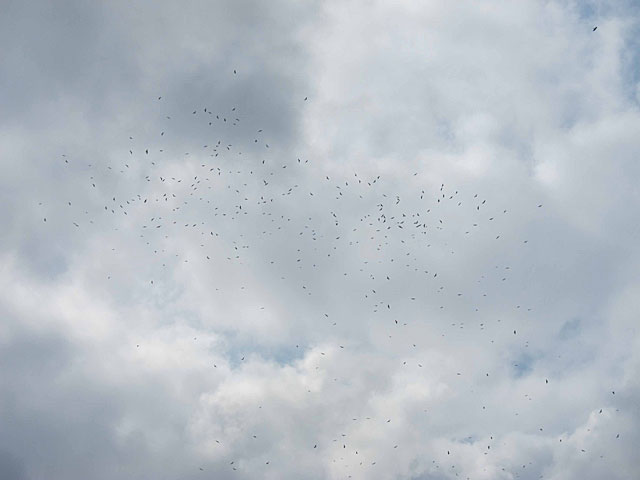
A tidal wave of Honey Buzzards..
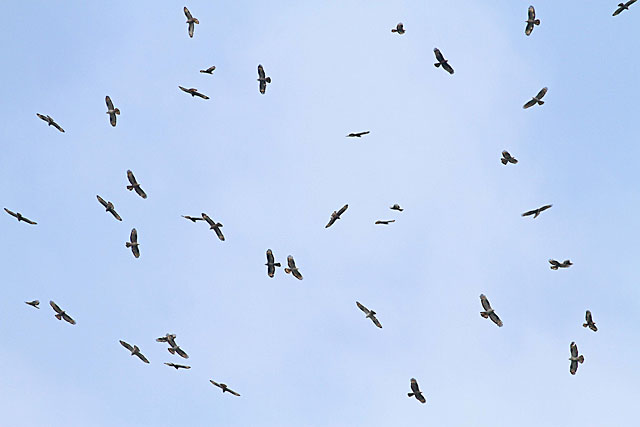
Many of whom were close
Away from raptors, we explored the Chorokhi delta area south of Batumi over the four days we were there. A small pool on the edge of the delta proved to be one of the unexpected gems of the trip; while trying to shelter from the heavy rain, we found a brace each of Little Crakes and Water Rails creeping around in the vegetation choked pool and the next day revealed an incredible nine Spotted Crakes, four Little Crakes, a Baillon’s Crake and eight Water Rails!
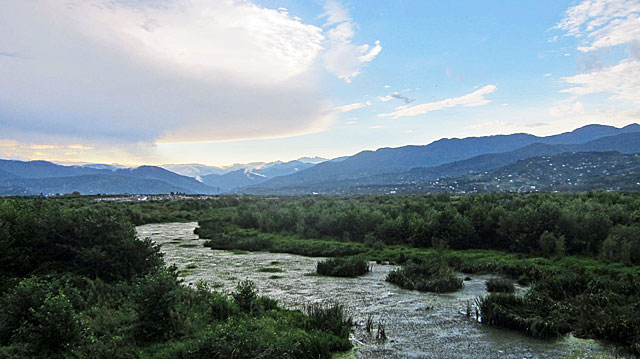
The Crake magnet
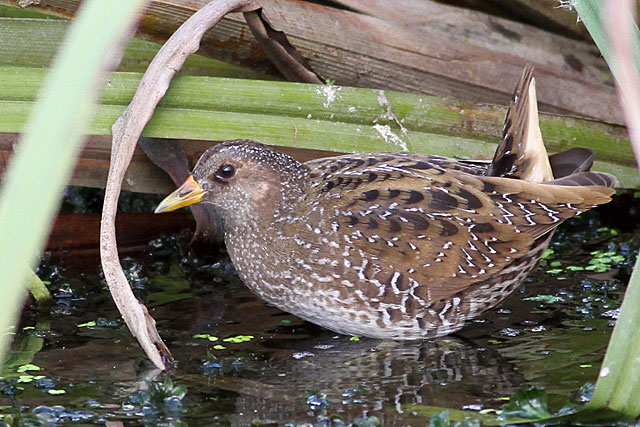
An accommodating Spotted Crake
As if this wasn’t enough, a “fallout” of five Caspian Stonechats occurred, a Savi’s Warbler was found showing out in the open in a small tree, a Paddyfield Warbler showed well and a Blyth’s Reed Warbler was photographed! An amazing selection of species in a tiny area, and proof of the power of rain to down tired migrants. This was also our best shrike day, with at least 15 Red-backed logged, plus two Lesser Greys. The raptor passage was fairly quiet again and the Honey Buzzard stream was pretty distant today, but we did get about 1000 (!) Bee-eaters migrating past us, along with over 3000 Black Kites again and a bonus White-tailed Eagle.
Our last morning in Batumi came too quickly, but after another quick look at the migrant spots, we headed inland along the Chorokhi River and up into the Lesser Caucasus. After a hearty lunch along the way, we arrived at the high pass (altitude approx. 2100m) and almost immediately found Krüper’s Nuthatch and a couple of samamisicus Redstarts. A small group of Red-fronted Serins tinkled around the small holdings at the pass, as did the local and distinctive races of Linnet and Black Redstart. At the impressive Zekari Pass we failed to find the enigmatic Caspian Snowcock, although we heard them, We soldiered on and had yet more raptor passage, with about 15 Pallid Harriers and a Golden Eagle being the highlights, and approximatel. 10 Caucasian Chiffchaffs showed well. More of a surprise were the Marsh Warbler and Thrush Nightingale that were at the highest point of the track in the stunted vegetation!
Our first few km on the plateau after the town of Akhalkalaki were amazingly rich. A flock of Armenian Gulls foraged in nearly ploughed fields, Calandra Larks flew over us and around 1000 Corn Buntings were seemingly everywhere. Most impressively though were the raptors, or more specifically the 30 or more Long-legged Buzzards.
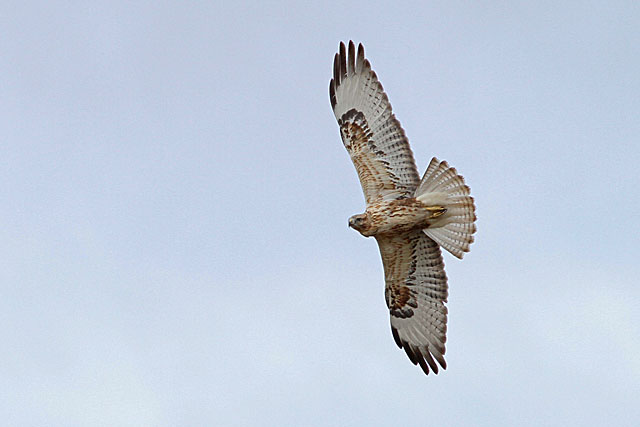
A juvenile Long-legged Bozzard
The lakes themselves varied in character. Lake Kartsakhi on the Turkish border held a nice flock of 58 Dalmatian Pelicans (with 1 White Pelican thrown in for completeness), while Khanchali lake was simply chock full of birds. Estimates of 10,000 Coots and smaller numbers (although still thousands!) of dabbling ducks were made, along with 150 White-winged Black Terns and a family group of Common Cranes. These Cranes are of the highly localised race archibaldi, which only breed in the Javakheti area of Georgia, the extreme NW of Armenia and the extreme NE of Turkey. The breeding population is very small, but with their yellow eyes and lack of any red on the head, the adults are quite distinctive. Many species are split on far less…
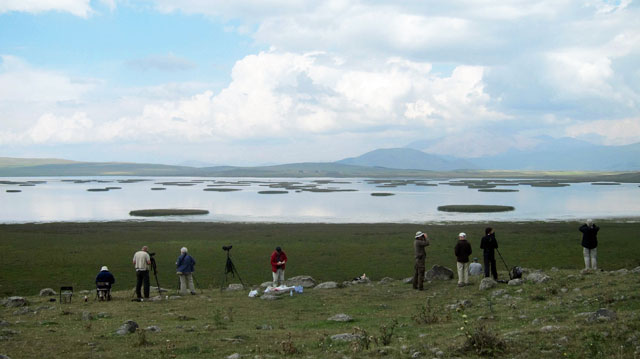
The lakes district
Our last days birding was restricted to a couple of hours in the morning around our hotel in Vardsia Cave Town, a rocky gorge area on the edge of the plateau. Finally, Green Warbler gave itself up to the group with two showing very well along with an adult male Red-breasted Flycatcher in the hotel gardens. Behind the hotel, up to six Rock Nuthatches loudly defended their territories and three Egyptian Vultures soared over the valley as approximately 100 Bee-eaters reminded us that migration was in full swing, even here.
September 12:
Rich Hoyer on the conclusion of his Oregon tour
The tour’s final flourish in the marshes, mountains, and basins in eastern Oregon was such a delight. With a Pacific frontal system arriving about a month early, the weather was utterly glorious, with cool mornings (even a light frost one day!), fresh breezes, and a warming fall sun. Delicious and varied picnic lunches every day (made more tasty by the gorgeous surroundings) added to the fun birding.

Even owling was successful with a surprise Northern Saw-whet Owl and spectacular views of a Flammulated Owl that appeared in record time.
One exception would have been the lack of Black Rosy-Finches at Steens Mountain, but the magnificent vistas and numerous raptors (such as Prairie Falcon and Golden Eagle below eye level) made this one of the most memorable days. We also saw Green-tailed Towhee, Cassin’s Finches, and migrant Red-breasted Nuthatches, Townsend’s Solitaires, and a very inquisitive female Calliope Hummingbird that darted in and about all of us.
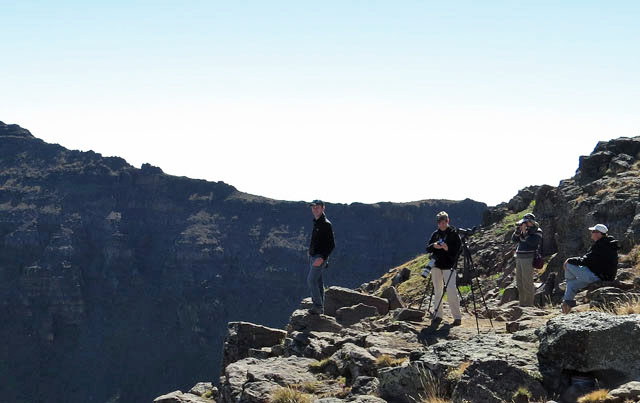
Steens Mountain
A similar overlook at Summer Lake’s Winter Ridge provided us with a memorable Canyon Wren experience.

Canyon Wren
In the valleys below we spotted many perched raptors (Ferruginous Hawk, Swainson’s Hawk, Golden Eagle, countless Red-tails), Sage Thrasher, Sandhill Crane families, and several close herds of the endemic American family, the Pronghorn.

Pronghorn
We also saw all eleven expected species of woodpecker, with some very lucky encounters, such as this Black-backed Woodpecker in a burn which we wouldn’t have known about but for the help of Tim Blount, one of several birders statewide who made important contributions to our tour.
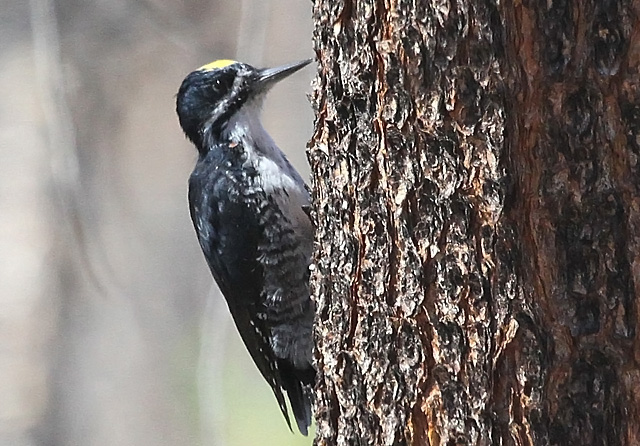
Black-backed Woodpecker
September 11:
Susan Myers from her on-going tour of Borneo
We Got the Hat Trick! This year our stay on Mount Kinabalu in Borneo was nothing short of sensational! We arrived after lunch in the pouring rain and were somewhat despondent about our prospects. As it turns out the rain was probably a blessing in disguise as the next day was all action. We started our birding at the top of the road through the national park, a place called Timpohon Gate where every day large numbers of tourists start their trek up the mountain, the highest between the Andes and the Himalayas. We, on the other hand, were contrarians and walked in the opposite direction, making our way down the hill in search of the many exciting birds to be found in this center of Bornean endemicity. One of our very first encounters was at a fruiting bush containing three Golden-naped Barbets almost at arms length.
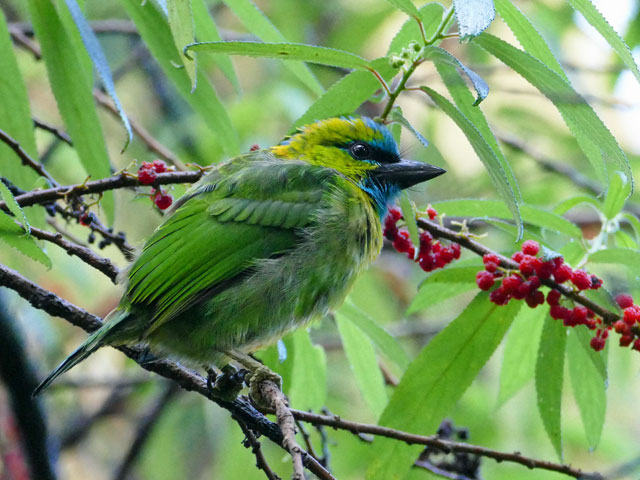
Golden-naped Barbet
This was followed in rapid succession with absolutely first class views of some other exciting endemics including Bornean Whistling-Thrush, Chestnut-hooded Laughingthrush, Mountain Blackeye
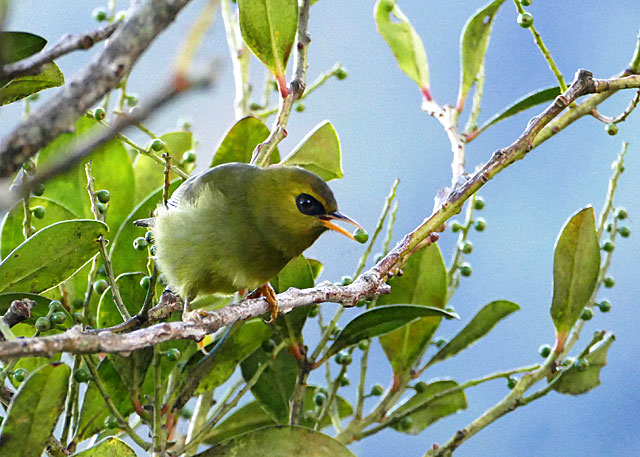
Mountain Blackeye
and Bornean Treepie. As we dodged the rain our days on Kinabalu just continued to get better! On our way to the mountain we stopped at a mid level area we the highlight was a brilliant Whitehead’s Spiderhunter, this was followed up with amazing encounters with Whitehead’s Trogon
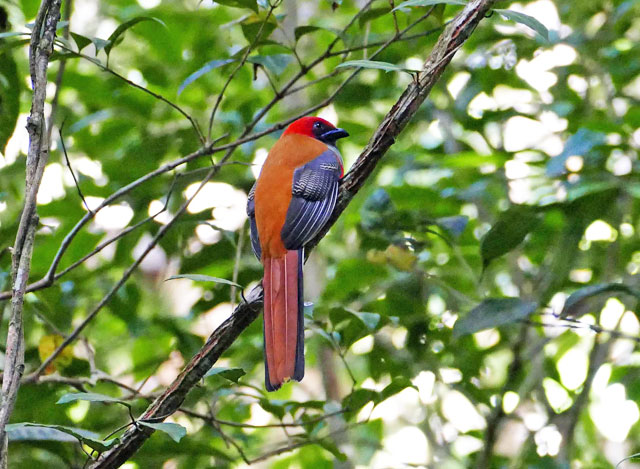
Whitehead's Trogon
and then our much hoped for Whitehead’s Broadbill, thus completing the famous Bornean birding hat trick. We can’t forget the mammals, though. The remarkable Whitehead’s Tufted Squirrel completed the Whitehead set for us and we couldn’t have been happier. To top it all off we enjoyed better than excellent looks at the two endemic partridges, Red-breasted (a group of seven with a chick!) and Crimson-headed. Cooperative Bornean Stubtails (the leader’s favorite Bornean bird…) and Mountain Wren-Babblers rounded out an almost perfect stay at this remarkable Endemic Bird Area. Next stop: the Kinabatangan River in search of Rhinos and Pittas!
PS: We had point blank views of Giant Pitta this morning... That just never happens!
Thanks to David Fisher, colleague and tour participant, for the use of his images.
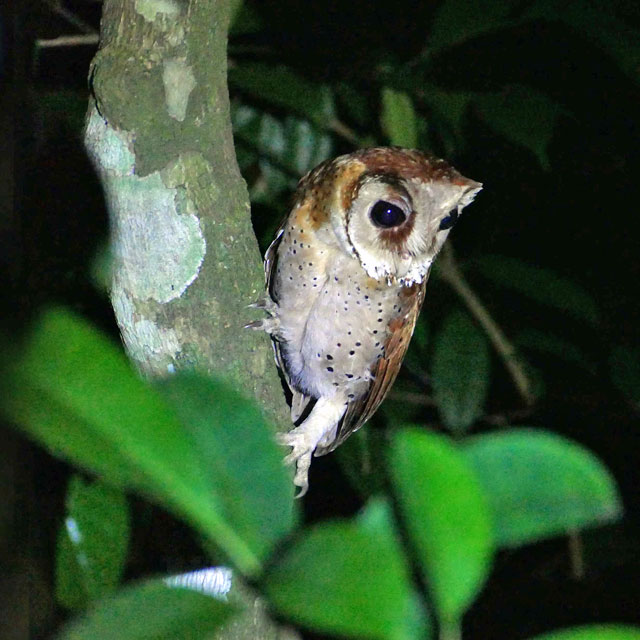
Oriental Bay Owl
August 31:
Rich Hoyer from his ongoing tour, Oregon in late Summer
We've just completed the western half of our tour, and it's been gorgeous here with some really fine birds. We began with a very successful pelagic trip, a highlight being high numbers of very close Black-footed Albatross and Fork-tailed Storm-Petrels.
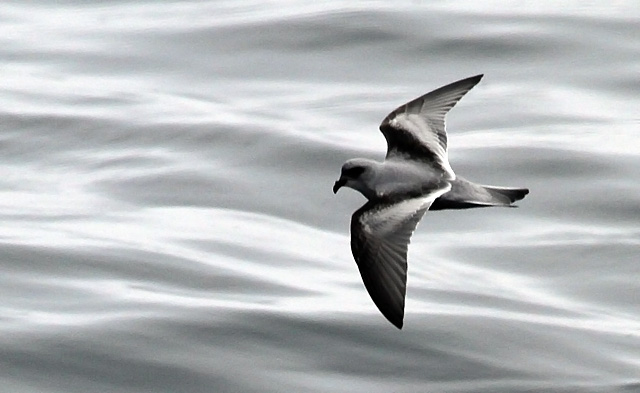
Image: Fabrice Schmitt
One albatross was so close that Fabrice Schmitt, a WINGS leader on a "busman's holiday" as a tour participant, got a photo that showed it had a band – and a readable one. We've already discovered that it was banded as a very young juvenile six years ago on Tern Island in the French Frigate Shoals of Hawaii, about halfway between the main islands and Midway!
Our first full day in the coastal town of Florence was stunningly beautiful

and the beauty wasn't limited to the fabulous landscapes. A swirling Sanderling ballet videoed by Fabrice can be seen here.
Continuing to the Willamette Valley and Coast Range we took a lovely walk up to Mary's Peak preceded by two coveys of Mountain Quail and a Pileated Woodpecker. We learned about White-breasted Nuthatches with the very obliging aculeata subspecies of the Pacific form near Corvallis,
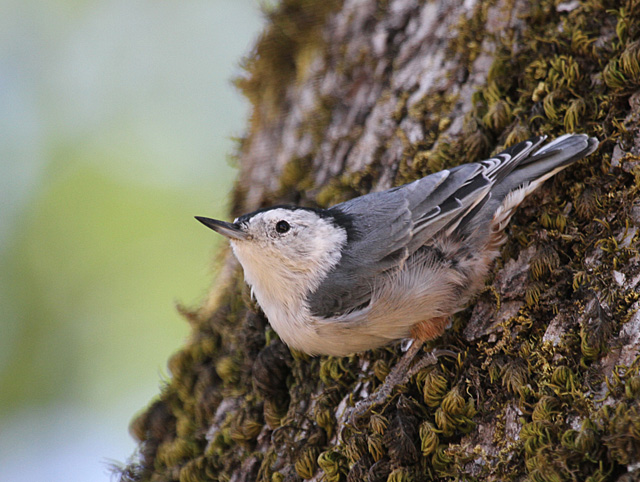
and enjoyed an incredibly birdy morning at Fern Ridge Reservoir with rare Sanderling and Franklin's Gull, as well as a juvenile Peregrine Falcon being harassed simultaneously by juvenile Cooper's and Red-shouldered Hawks.
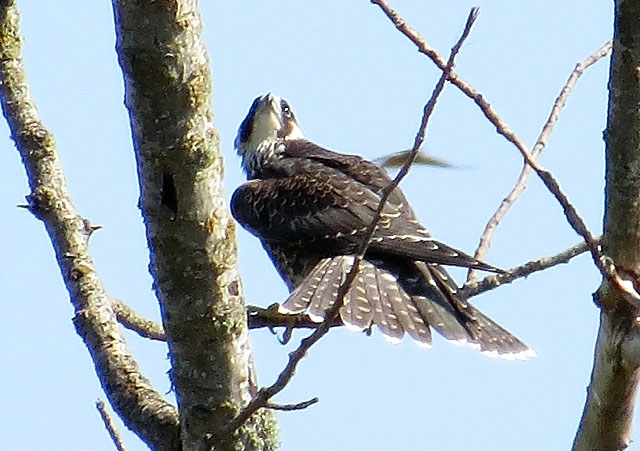
We're now headed to the east side pine forests, marshes, and sagebrush steppes, where lots of fun stuff awaits us.
August 28:
Paul Holt from his just-concluded tour, China: Lhasa and the Tibetan Plateau
This year's tour was superbly memorable encountering a wide variety of awesome birds and mammals amidst truly spectacular 'Roof of the World' surroundings. We saw almost all of our target species with highlights including a cooperative, but typically brief, Chinese Grouse; a spectacular performance from several Przevalski's Partridges; superb looks at both Tibetan Eared and up to 16 Blue Eared Pheasants; majestic Black-necked Cranes on no less than four days; four Amur and up to 13 Saker Falcons in a single day; a prolonged encounter with a family of Henderson's Ground Jays; Ground Tits galore; great looks both Mongolian and Tibetan Larks; White-browed Tit-warbler and more Phylloscopus warblers such as Gansu, Smoky Tickell's and Alpine Leaf than you could shake a stick at; Guldenstadt's Redstart; a complete haul of the region's snowfinches; Mongolian Finch, six species of rosefinch including Pink-rumped and Tibetan and all of Tibet's endemics with Brown-cheeked Laughingthrush and Giant Babax both putting in superb appearances.
For the umpteenth year we again saw the full set of Przevalski's Plateau birds - his partridge, nuthatch, redstart (arguably the prettiest member of the genus) and no less than seven of his finches - the latter a taxonomic enigma that was once a rosefinch then a bunting and now has its own family!
We also reveled in some superb mammal encounters including five Tibetan and three Red Foxes, two Wolves, four wild Yaks, over 100 Kiang (also known by the less flattering name Tibetan Wild Ass), 800 Tibetan Gazelle in a single day & last, but certainly not least no less than 65 Tibetan Antelope.
We watched birds against the stunning backdrop of the high altitude lake Qinghai Hu (Koko Nur to many), spent a fabulous day on the train to Lhasa (the highest elevation railway on the planet) and somehow also managed to fit in a full days sightseeing in Lhasa were we ventured in to the mighty Potala Palace!
We have a ground agent that looks after us like no other and enjoyed superb food and good quality accommodation throughout. Its not an exaggeration to say this was a brilliant trip and a great insight into life in Tibet and on the 'Roof of the World'!
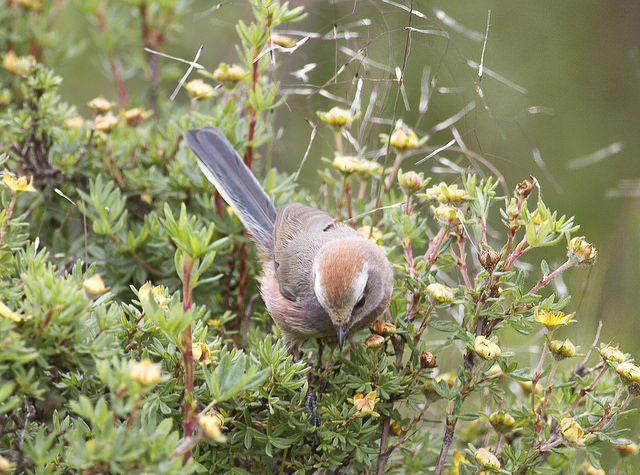
White-browed Tit-warbler
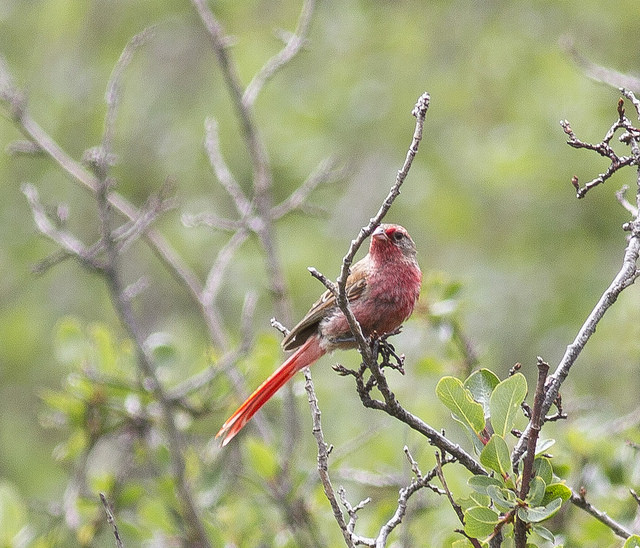
Przevalski's Finch
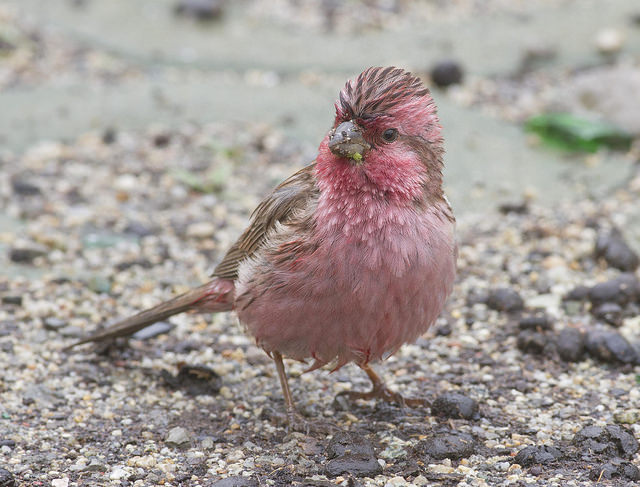
Stresemann's (Pink-rumped) Rosefinch

Potala Palace
August 22:
Rich Hoyer on his just-completed Marvelous Mato Grosso, Brazil tour
On this year’s Marvelous Mato Grosso tour, the Jaguar near the end was a highlight for almost everyone but the Yellow Anaconda and Giant Anteater were close contenders, and they’re even more rarely spotted. But this was indeed a birding tour, and we tallied some 450 species including some really good ones. At Chapada dos Guimarães it was hard to choose between the unexpected male Coal-crested Finch (photo below), a Collared Crescentchest (one of the first birds of the morning), the stately Red-legged Seriemas, iconic Red-and-green Macaws, the shockingly colored Helmeted Manakin, or the drab but seldom seen Pale-bellied Tyrant-Manakin.
Then came our short week at Cristalino, with challenging but extremely rewarding birding. We had a few highlights on the trails, such as a Gould’s Toucanet, Pavonine Quetzal, and a singing (and seen) Musician Wren on the giant Brazil Nut Tree trail (below). Giant Otters and fabulous puddle parties of butterflies on the river (below) were a highlight, as was our time on the canopy towers where a Tooth-billed Wren at eye-level and looking down on a White-necked Puffbird (below) were some of the memorable sightings.
We reached the Pantanal a bit apprehensive with an approaching cold front and with news that water levels have never been higher this late in the dry season. But there was no need to fear. Birds were abundant and easy to see everywhere, such as the Toco Toucan (below) and Crimson-crested Woodpeckers at Pouso Alegre Lodge pictured below. We made many roadside stops for birds and animals, the first being a Giant Anteater (below if distant) in a termite mount-studded pasture on our arrival afternoon. Then on the way south to Porto Jofre an 8-feet-long Yellow Anaconda (below) was spotted on the shoulder by our driver Robson, and we watched cross the road. Then came the excitement of the boat rides on the Cuiabá River, and in our first afternoon, in the midst of the cool and windy cold front, Giant Otters and Capybaras were the only mammals we spotted. But on the next morning ride we receive radio news of a pair of Jaguars, which we arrived in time to see slink off into the deep grass from our boat. Then 20 minutes later came the prize animal, a female furtively watching a pair of Capybaras on the opposite bank (below). The whole tour was a fabulous experience from beginning to end.

Coal-crested Finch
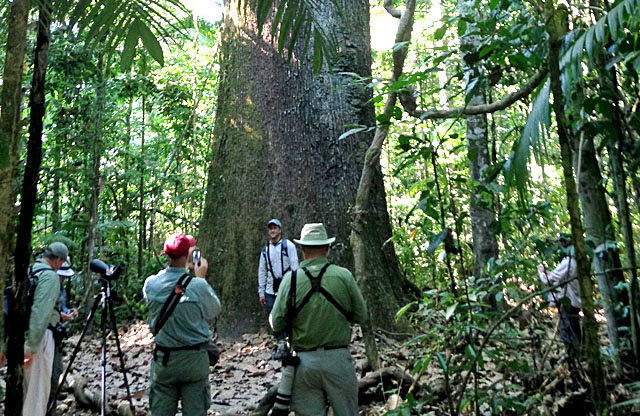
Eight hundred-year-old Brazil Nut Tree
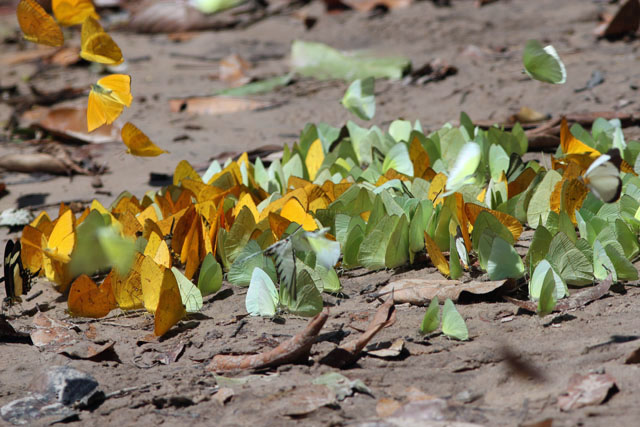
Just one of the amazing "puddle parties."
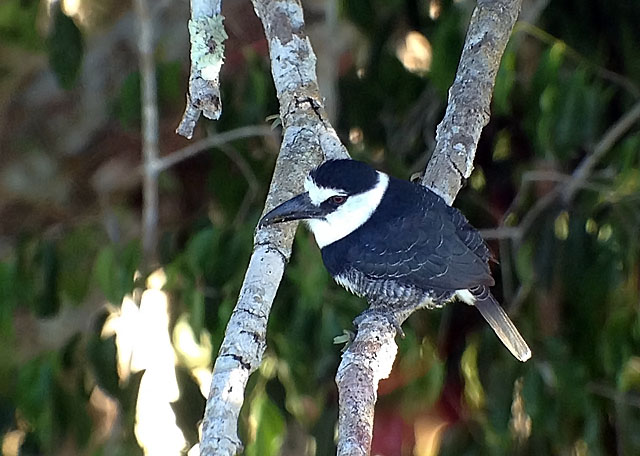
White-necked Puffbird

A brilliant Toco Toucan
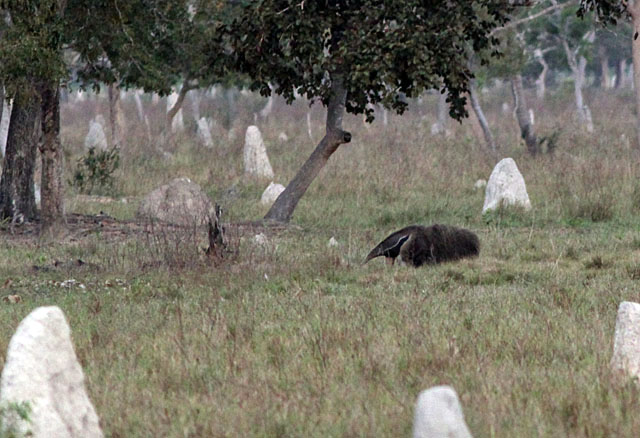
A Giant Anteater at work in tne termite fields

A speed bump...No, a Yellow Anaconda
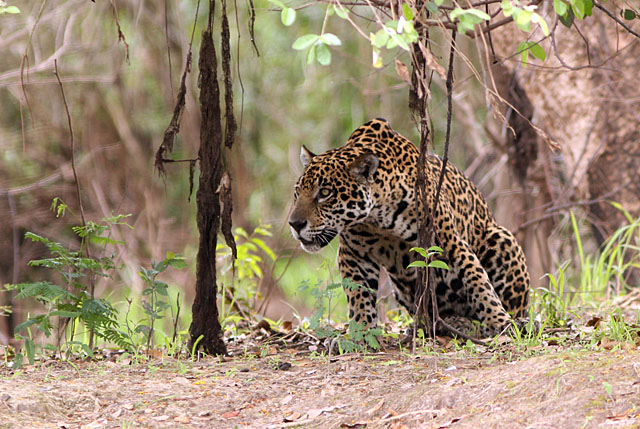
A most riveting Jaguar
